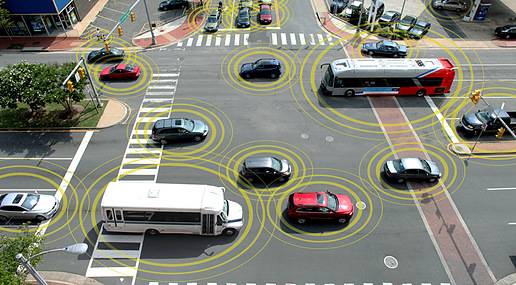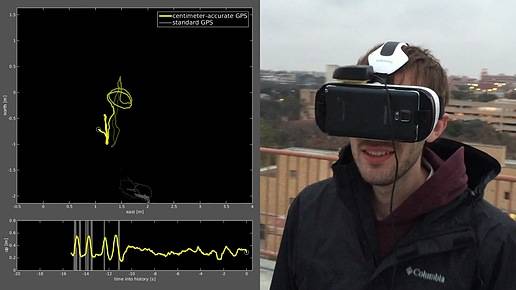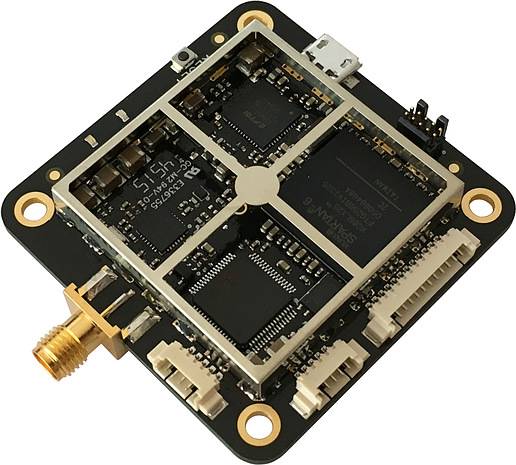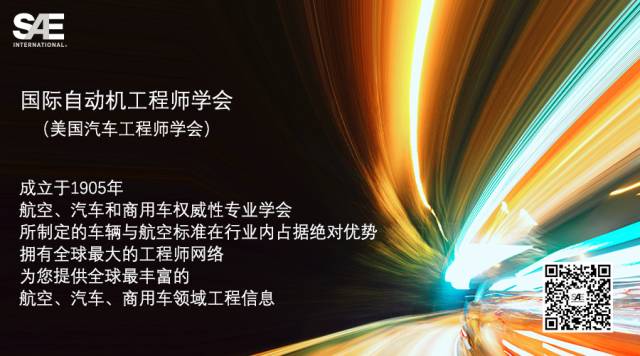 在许多无人驾驶原型车中,摄像头、激光雷达和雷达组将协同工作,提供支持安全冗余的360°传感。
在许多无人驾驶原型车中,摄像头、激光雷达和雷达组将协同工作,提供支持安全冗余的360°传感。 如今,V2V和V2I通信系统的优化将助力超高精度GPS系统的发展。
如今,V2V和V2I通信系统的优化将助力超高精度GPS系统的发展。 2015年,德克萨斯大学奥斯汀分校的工程师展示了精密“厘米级”GPS全球定位软件在智能手机上的应用,用户可通过虚拟现实头盔观看3D地图。
2015年,德克萨斯大学奥斯汀分校的工程师展示了精密“厘米级”GPS全球定位软件在智能手机上的应用,用户可通过虚拟现实头盔观看3D地图。 Swift Navigation公司基于软件定义的新型Piksi Multi双频GNSS接收器,可以提供快速的“厘米级”定位服务,公司称这款产品的成本不高。
Swift Navigation公司基于软件定义的新型Piksi Multi双频GNSS接收器,可以提供快速的“厘米级”定位服务,公司称这款产品的成本不高。
如今,在各种先进技术的支持之下,汽车和卡车的真实工况性能和稳健安全表现都有了大幅的提升。不过,除了常见的高级驾驶员辅助系统 (ADAS)、基于人工智能的机器学习技术、V2V/V2I通信、高分辨率3D街道地图以及数字双控制系统外,未来还有哪些技术将逐步突显,助力自动驾驶汽车的发展呢?
专家认为,新一代GPS(全球定位系统)卫星导航系统有潜力发展成为一种颠覆性技术。该技术可以精准定位车辆或卡车的实时位置,为自动驾驶汽车提供可靠性冗余误差不会超过5厘米。这种设计很有必要,因为随着时间的推移,传感器总有一天会出现某种程度的退化,甚至完全报废,也正是因为这个原因,汽车设计师总是会在汽车上部署多个传感器。
一旦“厘米级”GPS系统的成本下降至单价30美元以内,这种技术就可以作为一种有效的可靠性冗余,广泛应用于大量汽车中。
精确GPS
最近,科技市场分析机构ABI Reserch发布了一份针对超高精度卫星导航技术的预测报告,称低成本、高精度的GPS/GNSS(全球导航卫星系统)接收器可能将很快成为现实。
ABI公司首席分析师PatrickConnolly表示,到2021年,精密GPS将逐步登陆无人驾驶汽车、无人机,甚至智能手机。
“现在,汽车行业正在评估比较各种相互竞争的技术,但我们认为未来的汽车行业将逐步采用一种混合性措施,也就是说混合采用传感器、传感器融合和精确GNSS系统。”Connolly指出,“考虑到现阶段GPS接收器的单价已经下降至50美元以下,我们认为,未来的定位技术服务市场将得到一定发展,比如一些中高端车型内采用的人工现实和抬头显示器等。”此外,V2V通信也有可能有力推动自动驾驶汽车的发展。
Connolly表示,GPS只是作为备用,并不是主传感器。精密卫星导航功能预计可以提供可靠性冗余,为自动驾驶汽车的安全系统提供有力补充。Connolly指出,当然了,全球定位系统(GPS)也有一些自身固有的问题,比如信号阻塞、多路径干扰等等,但如果价格合适,这种定位系统绝对可以成为SAE 4级和5级自动驾驶车辆的有力助手。
GPS的工作原理
简单来说,GPS/GNSS卫星将按照设定轨道环绕地球运行,并向地面传送卫星和信号信息。接着,GPS接收器将接收到这部分数据,并利用“三边测量”的方法计算用户位置。
从本质上讲,GPS接收器可以比较信号的发送和接收时间,而后利用这种时差,或者说是“飞行时间”计算卫星的距离。GPS系统将从至少4颗卫星接收测距数据,其中3颗用于定位,1颗用于确定接收器的时钟偏移。
奥斯丁市德克萨斯大学副教授、该校无线电导航实验室主任Todd Humphreys表示,大多数手持GPS接收器均使用单频GPS信号,可以将定位误差控制在3m之内,而商用级映射接收器的误差大约在1m之内。
Humphreys教授解释说,测量级差分定位系统的精度最高,在工作时需要基站和探测器的支持,至少需要从4颗卫星接收信号。
Humphreys表示,即使附近没有基站,双频接收器仍可以通过一种名为“精准单点定位”的技术,综合利用精准卫星钟差、辅助“历元间”分析及电离层状态模型等外部信息,将精度控制在厘米级别。
Humphreys解释道,“但问题是,精准单点定位的效率很低,大概需要几十分钟才能收敛不到10CM的区域。”另一种定位方法是RTK定位。
传感器协助
ABI的Connolly指出,精密GNSS系统可通过多种手段将精度控制在1m之内,其中包括利用一个参考站网络。他表示,现阶段最大的问题并不是成本,而是“如何利用参考站提供的补充位置信息或其它来源,支持RTK或PPP定位的修正,进而实现可靠卫星导航系统的全球覆盖。这项工程耗资巨大,目前并无法看到清晰的投资回报。
工程师和技术人员想知道传感技术优化的潜力,以及这能将怎样减轻车辆自动控制系统在机器学习方面的负担。“如果你能用到更好的传感技术,你就能更轻松地解决更多与ADAS技术有关的问题。”Humphreys表示,举个例子,如果出现雨雪、大雾遮挡道路标记或道路边沿,甚至是在夜间视野不佳的情况,车辆的传感器和图像识别系统均有可能表现不佳。
Humphreys表示,下一代GPS就相当于地面上的“仪表飞行”技术”。除了成本更低外,“GPS系统的另一大‘优势’就是能够极大地减少这些系统计算修正所需的时间。”
去年,德州大学奥斯丁分校的创业公司Radiosense展示了精密卫星-导航定位系统在智能手机上的应用,获得了三星的项目支持。不过,Humphreys表示,这种解决方案很“脆弱”。
公司团队使用了多种复杂的信号处理技术,来处理数据输入并降低源自多路信号与射频信号阻塞的误差。目前,这家公司正在测试一款低成本的车道偏离预警系统,该系统可以从分布在市内多个位置的十几个基站获得实时修正。
下一代预测性GPS
如今,定位技术领域的竞争非常激烈,各路选手同场竞技,既有众筹创业公司,也有谷歌和阿里巴巴等互联网巨头。ABI公司称,目前的主要选手包括精密接收器供应商NovAtel、天宝导航(Trimble Navigation)、消费接收器制造商u-Blox、Skytraq Broadcom、高通(Qualcomm)意法半导体(ST Microelectronics),以及创业公司North Surving、NVS技术、REACH和SwiftNavigation公司。
举例而言,总部位于加州的Swift Navigation公司刚刚发布了最新Piksi Multi GNSS接收器。公司业务发展副总裁Rob Hrance表示,这款基于软件定义的接收器支持双频操作,能够以较低的成本提供快速RTK收敛和可靠的“厘米级”精密定位服务。
另外,一家名为EXO Technologies的以色列创业公司则开发了一种基于软件的技术。公司联合创始人及首席营销官Isaac Zafarani称,这种技术能够进行预测性修正,从而降低系统对互联功能的依赖,避免产生额外的计算量。他表示,EXO设备提供的卫星定位数据更方便,也就是说收集时间更短。
“我们绝大部分的GPS接收器均应用了实时修正,因此可以将精度控制在5到10cm。”Zafarani表示,“另外,我们的数据可通过互联网提供,支持全球覆盖。”
The list of technologies that could deliver the expected level of real-world performance and safety for robotic cars and trucks is long. Beyond today's advanced driver assistance systems (ADAS), artificial intelligence-based machine learning, V2V/V2I communications, high-definition 3D street maps and digital-twin controls, what other technologies will find their way aboard the autonomous vehicle?
Next-generation GPS (Global Positioning System) satellite navigation technology that can reliably and precisely locate a car or truck within around 5 cm (1.9 in) in real-time, could be a game-changer, providing back up, experts believe. That's because over time sensors will at some point deliver a degraded return or fail entirely. Vehicle designers deploy multiple technologies for this reason.
Should the cost of centimeter-accurate GPS location drop below $30 per unit, it could provide effective, reliable redundancy on a high-volume basis.
Pinpoint GPS
Such low-cost, precision GPS/GNSS (global navigation satellite system) receivers are nearly at hand, according to tech market analysts ABI Research, which recently issued a forecast on super-accurate sat-nav technology.
By 2021, precision GPS will begin to find its way into driverless cars, drones and even smartphones, said Patrick Connolly, principal analyst at ABI.
“Various competing technologies are now under investigation by the auto industry, but we believe that it will move to a hybridized approach, combining multiple sensors, sensor fusion technology and precision GNSS,” Connolly noted. “As the receivers’ unit price drops below $50, we expect to see a market develop for location technology services, such as artificial reality and head-up displays in higher-end vehicles.” V2V communications is another probable application.
GPS is not the primary sensor, but the back-up, he said. Precision sat-nav capabilities are expected to provide the essential redundancy to complete the safety systems for autonomous vehicles. Of course, GPS has its own inherent intermittency problems: signal blockages, multipath interference and so forth, Connolly pointed out. But if the price were right it could be an invaluable addition to the technology arsenal required for SAE Levels 4 and 5 driving.
How GPS works
GPS/GNSS satellites circle the earth in well-defined orbits and transmit satellite and signal information to the ground. GPS receivers take this data and use a "trilateration" process to calculate the user’s location. Essentially, the GPS receiver compares the time a signal was transmitted with the time it was received.
The time difference, or "time-of-flight," tells the GPS receiver how far away the satellite is. With distance measurements from at least four satellites—three for position and one to estimate any offset in the receiver’s clock—the receiver can triangulate the user’s position.
Most handheld GPS receivers use single-frequency GPS signals to achieve accuracies of about 3 m (10 ft), whereas commercial grade mapping units get within about a meter (39 in), according to Todd Humphreys, associate professor at the University of Texas at Austin and director of its Radionavigation Laboratory.
The most accurate type of GPS system, a differential survey-grade location system, requires a base station and a rover, each of which must receive signals from at least four satellites, he explained. Survey-grade GPS units, which are typically dual-frequency, have accuracies within 1 cm (.39 in) horizontally and 2 cm vertically, but cost $1,000 to $2,000 and more.
If no base station is nearby, Humphreys said, dual-frequency receivers can still achieve centimeter-level positioning via a technique called Precise Point Positioning, which integrates external information such as precise satellite clock timing, ancillary "ephemeris" predictions and a model of the current state of the ionosphere.
“The catch is that PPP can take tens of minutes to converge to a sub-10-cm solution,” Humphreys explained. Another such approach is real time kinematics (RTK).
Sensor assistance
ABI's Connolly noted that precision GNSS achieves sub-meter accuracy through a variety of methods, including a network of reference stations. He said the biggest question mark today is not cost-related. Rather, it is "how to achieve reliable, worldwide satellite navigation coverage using supplementary location information from reference stations or other sources to support correction techniques, such as RTK or PPP methods. This is a costly undertaking, currently with no guarantee of a return on investment, he said.
Engineers and technology researchers are interested in how far they can improve sensing to reduce the burden on the machine-learning aspect of the autonomous control systems in vehicles. “If you can cheat with better sensing, you can more readily solve many problems with ADAS technology,” noted Humphreys. Sensors and image recognition can perform poorly, for example, if lane markers or road margins are obscured by rain, snow or fog, even nighttime.
Next-gen GPS would be something like instrument-flying on the road, Humphreys indicated. Beyond much lower device cost, “the other ‘miracle’ would be to greatly decrease the time it takes for these systems’ calculations to converge to a corrected solution.”
Last year UT Austin’s own start-up Radiosense demonstrated precision sat-nav positioning on smartphones in a project supported by Samsung. The solution was "fragile," however, Humphreys reported.
The team uses sophisticated signal processing techniques to process the incoming data and reduce the errors that derive from multipath signals and RF signal blockage. Current testing involves a low-cost vehicle lane departure warning system that receives real-time corrections from a network of a dozen base stations set around town.
Next-gen predictive GPS
Competition in the location technologies segment ranges from crowd-funded startups to Internet giants Google and Alibaba. The cast includes precision receiver vendors NovAtel and Trimble Navigation, consumer receiver makers u-Blox and Skytraq Broadcom, Qualcomm and ST Microelectronics, and start-up firms such as North Surveying, NVS Technologies, REACH and Swift Navigation, ABI reported.
California-based Swift Navigation, for example, just introduced its Piksi Multi GNSS receiver, said Rob Hranac, vice president for business development. The software-defined receiver’s dual-frequency operation offers rapid RTK convergence times and reliable, centimeter-accurate positioning results at an increasingly affordable price, he stated.
An Israel-based start-up called EXO Technologies has developed software-based technology that generates corrections in a predictive manner, thereby reducing the dependency on connectivity and the need for additional computations, said Isaac Zafarani, co-founder and chief marketing officer. EXO’s device delivers better satellite position data, he claimed, which means faster acquisition time.
“Corrections are applied in real-time to most GPS receivers, resulting in 5- to 10-cm [up to 4 in] accuracy," Zafarani said. "And our data is provided through the internet, enabling global coverage.”
Author: Steven Ashley
Source: SAE Automotive Engineering Magazine
等级
打分
- 2分
- 4分
- 6分
- 8分
- 10分
平均分
- 作者:Steven Ashley
- 行业:汽车
- 主题:安全性人体工程学/人因工程学电气电子与航空电子
